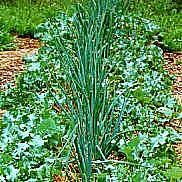Allium cepa
Onion, Cebolla
Temperate
Introduction
Onions are a large and much used family of plants that are native to what are now Afghanistan and Iran. They have been cultivated for at least 4000 years. The word 'onion' derives from the same root as 'union'. The concentric layering of leaf stems forming a bulb makes onion a useful metaphor for the union of seemingly separate entities and of the many layers of reality. Because of this, the plant has spiritual significance in many cultures.
Although it is most often thought of as a bulb vegetable, green onion leaves are eaten in most cultures under a wide variety of names. They serve as both vegetables and as culinary herbs due to the strong flavors. These flavors are released on cutting or crushing when the enzyme allinase combines with several sulfur compounds. It is these compounds, along with flavonols and quercitin that give onion and related alliums their reputation for fighting infections, heart disease and cancer.
Pros
- Modern investigations are proving many of the vaunted traditional health claims made for onions and garlic to be well founded. They have antibacterial, antifungal, anticoagulant, and anticarcinogenic properties.
- As long as the youngest five leaves are left, the older leaves can be usually be harvested without lowering bulb yield significantly. This makes onion a good dual-purpose crop.
- Green onions can be very productive. Closely related chives (A.schoenoprasum L.) can produce six to eight harvests of fresh green foliage per year, yielding up 8 tons per hectare, and bunching onions (A. fistulosum) have an average yield of 24 tons per hectare in Japan.
- Onions do well over a wide climate range and have some tolerance to freezing.
- Unlike onion bulbs, green onion leaves contain considerable amounts of vitamins A and C.
Cons
- Sensitive to waterlogging
- Shallow root system requires good supply of nutrients in the top few inches of soil for optimal growth.
- Sensitive to salt in the soil
- Requires careful weeding until well established
- Prone to fungal and viral infections in wet weather
Notes
- The allium genus includes roughly 500 species, most of which are used as food somewhere. Interspecific breeding is creating dozens of productive crosses such as onion-garlic and onion-leeks.
- Green onion tops or leaves can be easily dried in solar dryers for later use in soups and stews. The dried onion leaves can also be ground to a powder and used as a flavorful and nutritious spice in cooking.
- Onions prefer 20-30 inches of rain distributed evenly over the growing season.
- Best growth is in soil above pH 6.5 but below pH 8.0.
- Onions grown with too much nitrogen or nitrogen supplied late in their growth will not store well.
Seeds
- Most good mail order garden seed catalogs carry at least a couple of varieties of onion seed. Sets (small bulbs) and slips (small green plants) are often available in the early spring from garden stores. Onions from seed are slower and a bit more difficult to keep weeded, but yield onions with better storage properties.
Related Plants with Edible Leaves
A.schoenoprasum L (chives.); A. fistulosum (bunching onions); A. sativa (garlic); A.ampeloprasum var. porrum (leek); A. tuberosum (Chinese chives)
